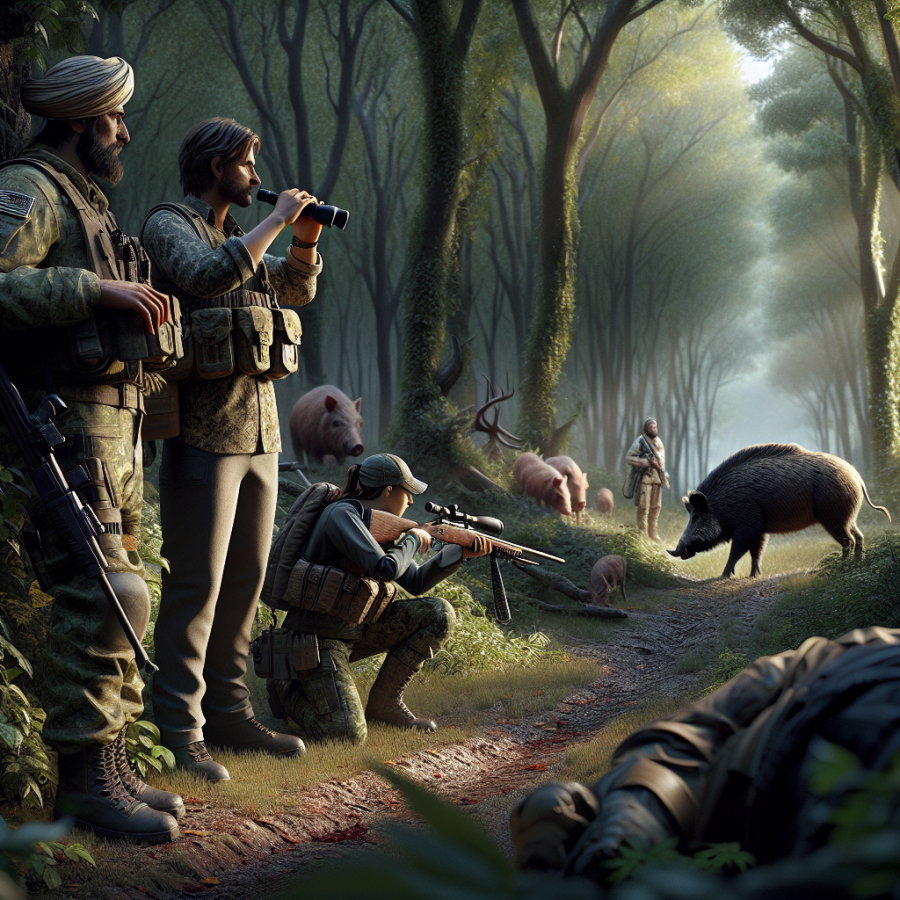Equipment and Tactics: Preparing for the Hunt and Making the Perfect Shot
When embarking on a boar hunting expedition, it's imperative that you are not only mentally ready for the task at hand, but also physically equipped with the right gear and techniques to ensure a successful and ethical hunt. Below are some tips and strategies for selecting the right equipment and employing effective tactics in the pursuit of boar.
**Choosing the Right Weapons and Ammunition**
The weapon you bring to the hunt can make a significant difference in your success rate. When hunting boar, your primary choices are usually between a high-powered rifle and a compound bow, depending on your preference and the regulations in your hunting area. A rifle calibre that is effective for boar hunting would typically be in the .30 caliber range, such as the .308 Winchester or the .30-06 Springfield. For those preferring a bow, a compound bow with a minimum draw weight of 50 pounds is recommended to ensure sufficient force to penetrate the boar's tough hide and vital organs.
In regard to ammunition, when using a rifle, choose bullets that are designed for maximum penetration and expansion, ensuring a quick and humane kill. Soft point or bonded bullets are often preferred as they are designed to expand upon impact, causing more internal damage. For archers, fixed-blade broadheads are recommended as they are less likely to be deflected by thick skin and bone.
**Appropriate Clothing and Protective Gear**
The right attire is crucial for both concealment and protection when hunting boar. Camouflage clothing will help keep you hidden in different environments, but be sure to tailor your pattern to the specific terrain you'll be hunting in. Additionally, wearing thick, durable materials can offer some protection against the underbrush and thorns you're likely to encounter.
Considering the aggressive nature of boars, safety is paramount. Investing in a quality pair of snake boots can protect you from venomous snake bites that are a potential hazard in many boar habitats. Moreover, some hunters might opt for specialized cut-resistant clothing or even chain mail underlayers in areas where the risk of a boar attack is particularly high.
**Optics and Scouting Equipment**
Having a strong set of binoculars can dramatically increase your odds of spotting boar from a distance, thereby improving your chance for a successful stalk and providing the opportunity to observe the animal undetected. Find an appropriate balance between magnification and weight for long treks. Spotting scopes can also be useful, particularly in more open terrain.
Read also:
Football vs. Soccer Cleats: Unveiling the Key Distinctions
Mastering the Terrain: Essential Tips for Tracking Wild Boar
When tracking wild boar, understanding the terrain you're venturing into is not just beneficial—it's an absolute necessity for a successful hunt. Boar, being intelligent and adaptable animals, are known to use the particulars of their habitat to evade hunters. Here are key insights you can employ to effectively track these elusive creatures:
1. Study the area: Before you set out, examine detailed maps and satellite images of the location. Look for natural water sources, dense underbrush, and food supplies, as these are areas where boar are likely to be found. Get to know the lay of the land so you can navigate quickly and quietly.
2. Identify signs of boar activity: Learn to recognize tracks, wallows, rubs, and rooting. Boar have distinctive split hoof prints, and their wallowing pits are often close to water. Trees with mud or hair on them, typically at the boar's shoulder height, could suggest a rubbing area. Rooting – overturned soil – indicates feeding spots.
3. Be mindful of the wind: Boars have a keen sense of smell, which they use to detect danger. Approach areas of potential boar activity downwind to avoid giving away your presence.
4. Move silently: This is where your familiarity with the terrain comes into play. Being able to tread lightly and avoid snapping branches or rustling leaves can make the difference between a successful track and a spooked boar.
5. Look for irregularities: In dense forests or bushland, even experienced trackers can struggle to find direct signs. Pay attention to disturbed bird activity or other wildlife behavior that might indicate a boar's movement.
6. Understanding boar behavior: Know when boar are most active. During hot days, they may wallow in mud or water to cool off, and they're typically more active during dawn and dusk. Adjust your tracking times accordingly.
7. Use GPS and traditional navigation tools: Technology can be an invaluable assistant in your tracking, but don't neglect the basics of using a compass and understanding topography. Electronics can fail, but your skills will endure when batteries won’t.
8. Patience and persistence: Tracking wild boar is often a waiting game. Be prepared to spend hours following signs before you catch sight of your quarry. Your patience can be a critical factor in a successful hunt.
By mastering the terrain and implementing these essential tips, you can enhance your wild boar tracking skills.




